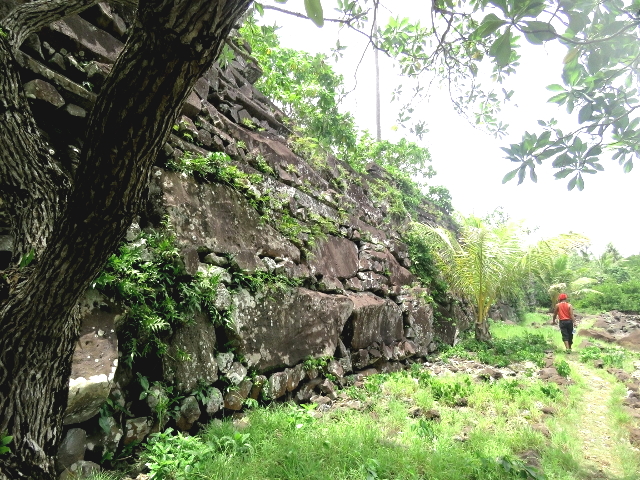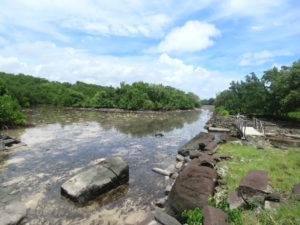
15 Mar Micronesia — The Walls of Nan Madol
Nan Madol is one of the most intriguing archaeological sites on the planet, and one of the least known. At least, I spent most of my life not knowing about it. It’s a series of megalithic stone structures situated on top of 98 artificial islets carved out of a coral reef. Archaeological evidence indicates construction started about 1180 and that the place was abandoned in 1628, which was before white people arrived so whatever happened, don’t blame us.
To get there you’ve first got to get to Pohnpei, a little dot of an island in Micronesia about halfway between Honolulu and Manila, which means taking the Island Hopper: a plane that flies three times a week from Guam to Chuuk to Pohnpei to Kosrae to Kwajalein to Honolulu, or the other way around, and is a lot less romantic than it sounds given the distances involved and the unfortunate fact that it’s operated by United, perhaps the world’s least passenger-friendly airline.
The airport is on the north side of the Pohnpei and Nan Madol is just off the south coast so, if you want to visit the ruins you have to make your way across the island, which is fun all by itself. Pohnpei is Hollywood’s dream of a tropical-island paradise. You bounce along for an hour-and-a-half past taro and banana and coconut and betel-nut farms and the occasional Japanese tank that’s been serving as a lawn ornament for the last three-quarters of a century.

Better than a pink flamingo
As you keep going the jungle gets junglier and the road peters out to a dirt track. At one point you come to a tropical-island waterfall cascading into a pool that looks like the setting for a cheesecake movie from the Nineteen-Fifties featuring maidens sitting on rocks combing their hair.

One tropical-island waterfall, please. Hold the maidens.
The jungle, it turns out, is owned by different families and, every now and then, you have to stop the car and walk up on somebody’s porch and pay a toll. At the last toll, you leave the car and head off on foot. This is not the kind of place you’re likely to be pestered by hordes of tourists.

A toll road through the jungle
The jungle turns into marshy land and, then, the land stops and you’re in a mangrove swamp looking at a stone structure on the other side of a shallow canal.

Nan Madol across the canal
The structure is big . . . Machu Picchu big. It’s made out of basalt columns stacked together like Lincoln logs, and the columns are big, too . . . some weigh as much as 40 tons.
They were quarried out of a volcanic plug on the far side of the island and are way too heavy to have come via bamboo raft or dugout canoe . . . which puzzles modern people trying to figure out how they got there. Nan Madol is the kind of place that some future charlatan will write a book about claiming space aliens built.
The stories the islanders tell aren’t any less far-fetched. According to legend, the columns were levitated in place by a pair of sorcerer-twins and a flying dragon.

Forty-ton basalt columns, brought to you courtesy of a flying dragon
The twins weren’t local, they showed up in a canoe from Western Kata. What Western Kata might be or, for that matter, what any part of Kata might be, has never been revealed to me. When one of the twins died, his brother became the first Saundeleur, married a local girl and fathered twelve more generations of Saundeleurs.
I’d never heard of a Saundeleur before going to Nan Madol, but it was a good gig, as good as being Inca.

A wall that would have done an Inca proud
There was only one of Saundeleur at a time so, if you were the one, there wasn’t any competition and you owned everything . . . the island, the trees and streams, the beautiful waterfall, the houses, the beaches, the fish, the yams, the taro, the coconuts, the people and all the landlords whose job it was to make sure everybody else grew enough yams and taro, and caught enough fish, and fermented enough breadfruit to keep you in a good mood.
The system started off benign enough, just a bit of seasonal tribute but, as any good economist could have told you, a priestly class sprung up, social controls tightened, the number of hangers-on blossomed until there were, maybe, a thousand people living at Nan Madol, all requiring food and fermented breadfruit and forced labor to keep the walls in shape . . . while everybody outside the walls starved as slaves.

An even bigger wall
Every living thing on the island had to be accounted for so that if you so much as squished a louse you had to carry the body to Nan Madol and turn it in.

High-class living quarters: where all the food and fish, fermented breadfruit and squished lice wound up
The first Saundeleurs don’t seem to have been so bad but, as the generations passed, they started acting like people with too much clout and too much time on their hands. Things got to the point where one used his sorcery powers to track down the fattest people on the island and eat them. The Saudeleurs aren’t remembered with wistful nostalgia by modern Pohnpeians.
From time to time people who weren’t the Saundeleur would get fed up and assassinate him, but it never did any lasting good. A new one would just spring up in his place. On one occasion, an especially gluttonous Saundeleur wife killed herself when the liver she scarfed down at a feast prepared by commoners turned out to be from her father.
This went on for hundreds of years until a new group of invaders kicked out the Saudeleurs and took over Nan Madol for themselves. By this time Pohnpeians had had enough of catering to foreign overlords and the newcomers had to forage for their own food and water, which led to their moving to the mainland and leaving the stone buildings for the mangroves.

Looking down a canal toward 96 more islands still enshrouded with mangroves


No Comments